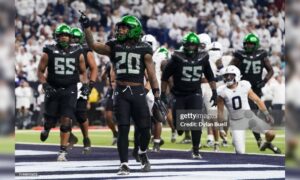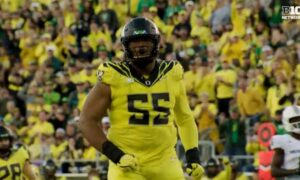New Pittsburgh Steelers running back LeGarrette Blount is a big back. There’s no disguising that fact behind his 6’, 250-pound frame. But that doesn’t necessarily mean that he runs like a big back, or that he’s always known how.
Make no mistake: Blount thrives on making contact and using his physical running style to pile up yardage through defenders—but he does it best in space. Since coming into the league, he averages the third-highest yards after contact per carry in that timeframe (as a rookie, he forced a league-best 50 missed tackles and averaged 3.68 yards after contact per carry).
But while he has excelled in gathering yards after contact, which would seem to be the hallmark of the ‘big back’, Blount has in many ways defied the stereotype, on both the positive and negative ends of the spectrum.
A product of the Oregon Ducks offense, Blount cut his teeth as a zone runner in college, going sideline-to-sideline and cutting upfield once daylight breaks, which is enabled by his sub-4.6 speed and above average agility for his frame.
This has caused him problems in the NFL when pigeonholed in short-yardage and goal line situations, in which he hasn’t always taken advantage of his natural physique to plow ahead for the first down or the score.
The Oregon playbook didn’t have a Power O page, or plays designed for the I-formation. “You don’t take the ball and go downhill at Oregon“, Blount said. “You take the ball and go lateral. Then, when you see an opening, that’s when you get vertical”.
He simply wasn’t asked to lower his shoulders and pound ahead when all that’s needed is one or two yards. It’s been a process throughout his entire professional career to adjust to and get comfortable with that running style.
As recently as this past December, during his most significant time while with the New England Patriots, head coach Bill Belichick advised him to change his running style to better take advantage of his natural frame.
Blount grew up playing upright, which makes him an easier target. Belichick taught him to lower his pad level and to be more decisive, and it has been a process to adapt to that position to the point that it feels natural, an issue only alleviated through repetition.
“You just got to do it a lot more than a lot of guys who are shorter than you”, he said. “You just got to keep doing it more often so it becomes a habit”.
As I wrote yesterday, this change helped Blount improve his success in short-yardage situations last season, most of which came in December. He toted the ball six times on goal-to-go situations last season, and he scored on four of them.
All of them, however, came on first down, and the two on which he failed came from one yard out. Yet three of his four touchdowns came from at least five yards out.
Nevertheless, it would appear that he still has room to grow when it comes to getting the tough yards in short-yardage and goal line situations, which are typically the realm of the ‘big back’, and if anything, that should be something to be excited about.







